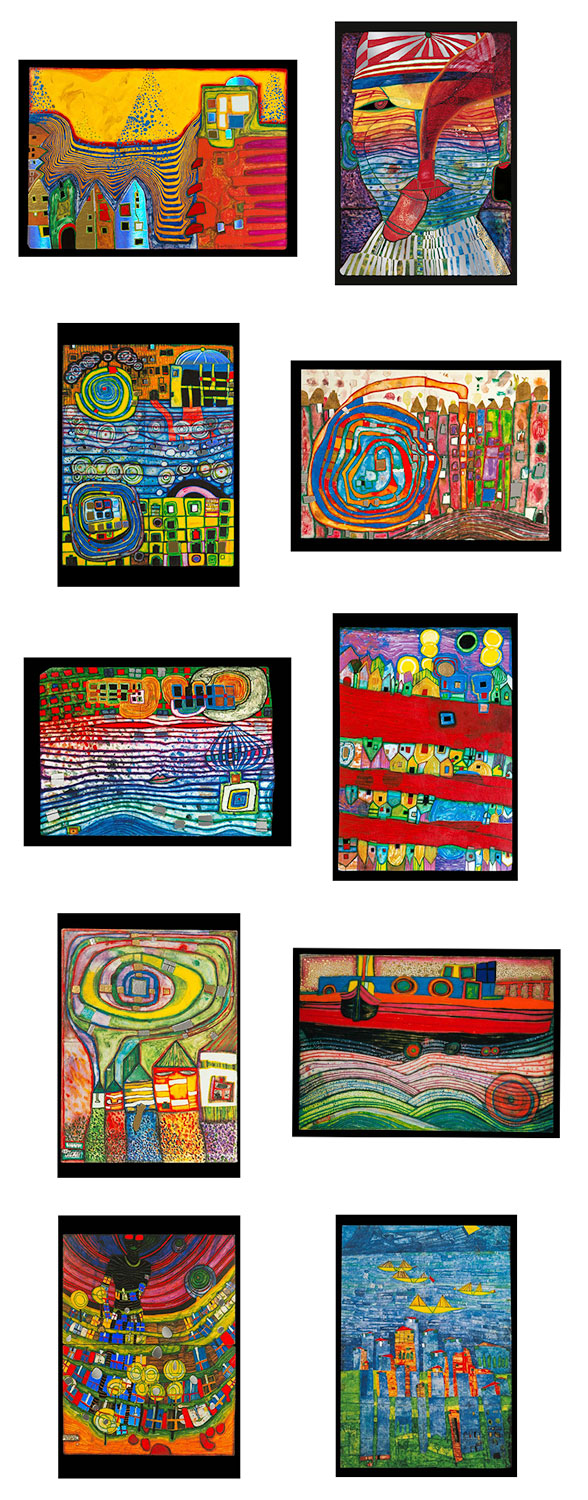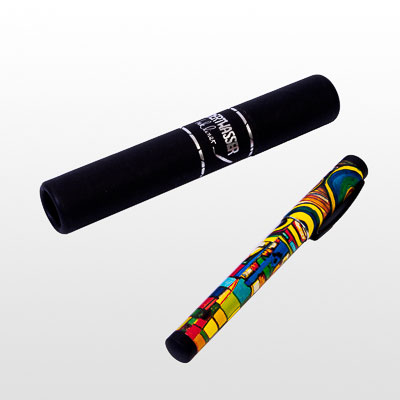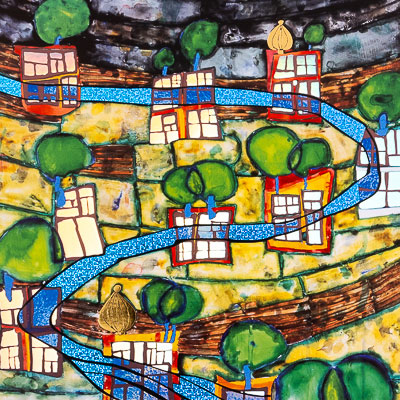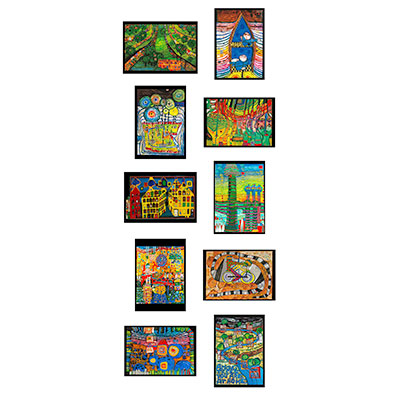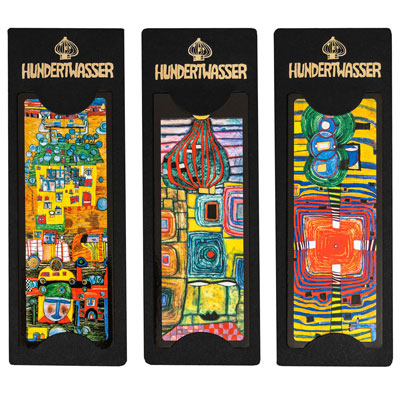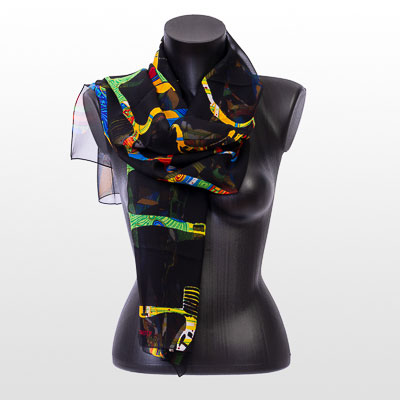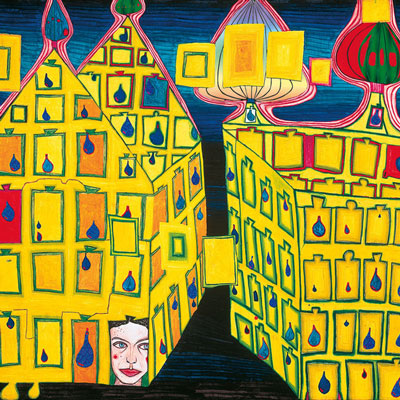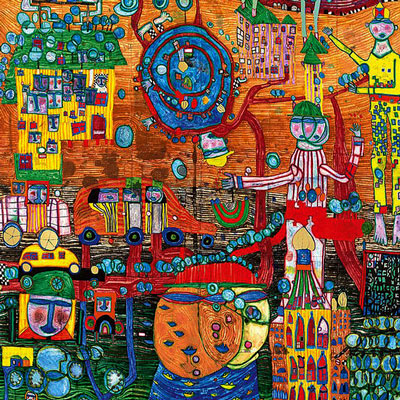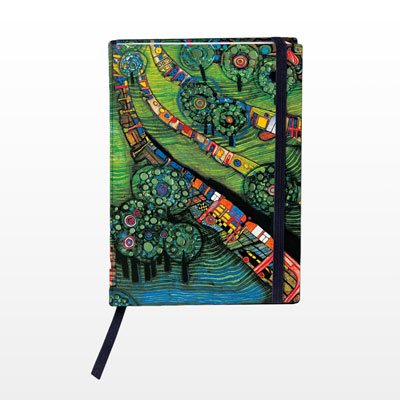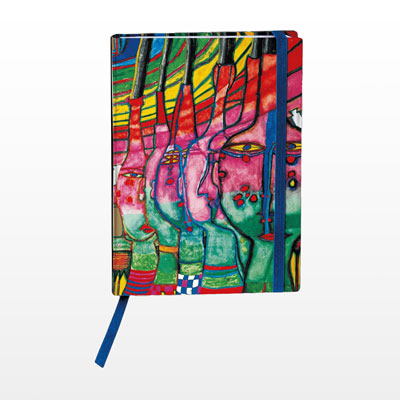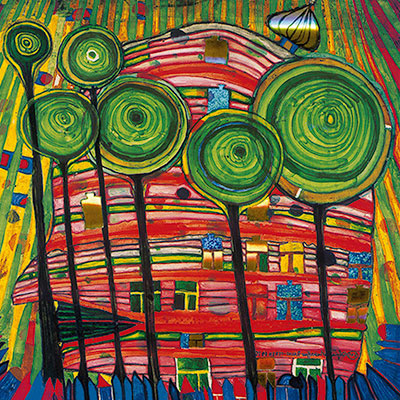Tel : (+33) 4 94 63 18 08
9am - 6pm from Monday to Sunday
All products Friedensreich Hundertwasser • Products of the topic Contemporary
10 Hundertwasser postcards (sleeve n°3)
REF : HUND-CP-03
In stock
Only 1 in stock
Unavailable
35,00 €
(37.87 USD)
Sleeve of 10 Friedensreich Hundertwasser postcards
Dimensions : 16 x 11.2 cm
The sleeve of 10 artistic postcards is a unique product for art and writing lovers. Printed on thick black cardstock of 450g, each card has a beautiful finish with selective varnish that brings the illustrations to life and highlights the details. The metallic embossing adds a touch of sophistication and luxury to each card. Use them to send personal messages to your loved ones or to decorate your office. These postcards are a perfect gift for anyone who appreciates art and quality and wants to add a touch of elegance to their correspondence.
Modern Art
The modern art movement in painting began at the end of the 19th century and continued until the Second World War. It saw the emergence of new forms of artistic expression that challenged traditional painting conventions. The first artists to move away from classical conventions were the Impressionists, such as Claude Monet, whose famous work "Impression, Sunrise" was painted in 1873. The Impressionists introduced innovative techniques such as the use of rough brushstrokes to capture the effects of natural light. With the arrival of the 20th century, new trends such as Fauvism, led by artists like Henri Matisse, who in "The Dance" 1909, used bright, saturated colors to create dynamic compositions. Abstract Expressionism, which emerged in the 1910s, saw artists such as Wassily Kandinsky and Frantisek Kupka explore new forms of abstraction to express intangible ideas such as emotions and sensations. Finally, Cubism revolutionized the conventions of representing reality by introducing multiple perspectives in the same composition. Pablo Picasso and his work "Les Demoiselles d'Avignon" of 1907, and Georges Braque with "Le Grand nu" also made in 1907, are examples of this. In summary, the modern art movement in painting was characterized by experimentation, breaking away from classical conventions, and exploring new forms of artistic expression. The works and artists mentioned here are just a glimpse of the many talents that have contributed to the wealth of this movement.
Discover the artist
Hundertwasser Friedensreich
Friedensreich Hundertwasser, whose real name was Friedrich Stowasser, was an Austrian artist known for his unique and colorful style that combined abstract art and architecture. He was born on December 15, 1928 in Vienna, Austria and died on February 19, 2000. Hundertwasser began his artistic career in the 1950s as an abstractionist, painting and printmaking. Over the years, he developed a style that combined elements of abstract art with elements inspired by nature, such as trees, leaves, and flowers. He also began to take an interest in architecture and designing buildings that he considered works of art in their own right. Hundertwasser was an environmental activist and used his art to raise awareness about environmental issues. He particularly designed buildings that incorporated elements of nature, such as rooftop gardens and trees inside buildings. He was also a fervent opponent of Euclidean geometry, advocating for organic architecture that is closer to nature. He referred himself as "anarchitect" rejecting conventions, standards, and codes. One of Hundertwasser's most famous achievements is the residential building "Hundertwasserhaus" in Vienna, which was built in 1985 and is considered one of the most important examples of organic architecture. He is also known for other architectural projects such as the "Krawinkelnhaus" in Bregenz, Austria and the "Hundertwasser-Therme" in Bad Blumau, Austria. In addition to his architectural projects, Hundertwasser was also a prolific artist, with over 40 solo exhibitions in museums around the world. He was also an illustrator and author, publishing children's books and poetry books. Hundertwasser died of a heart attack during a trip to New Zealand in 2000, but his artistic and architectural work continues to inspire and be exhibited around the world. His architectural accomplishments have become popular tourist sites and his art is considered one of the most important of Austria's second half of the 20th century. His vision of architecture as a living and organic work of art has had a significant impact on modern architecture, and his ideas continue to be studied and celebrated in architecture and contemporary art circles. In addition to his architectural achievements, Hundertwasser left behind a rich collection of paintings, prints, drawings, tapestries, and crafts that testify to his commitment to nature and the preservation of the environment. He was also a peace and social justice advocate, and his works often reflect these themes.
Hundertwasser Friedensreich
Friedensreich Hundertwasser, whose real name was Friedrich Stowasser, was an Austrian artist known for his unique and colorful style that combined abstract art and architecture. He was born on December 15, 1928 in Vienna, Austria and died on February 19, 2000. Hundertwasser began his artistic career in the 1950s as an abstractionist, painting and printmaking. Over the years, he developed a style that combined elements of abstract art with elements inspired by nature, such as trees, leaves, and flowers. He also began to take an interest in architecture and designing buildings that he considered works of art in their own right. Hundertwasser was an environmental activist and used his art to raise awareness about environmental issues. He particularly designed buildings that incorporated elements of nature, such as rooftop gardens and trees inside buildings. He was also a fervent opponent of Euclidean geometry, advocating for organic architecture that is closer to nature. He referred himself as "anarchitect" rejecting conventions, standards, and codes. One of Hundertwasser's most famous achievements is the residential building "Hundertwasserhaus" in Vienna, which was built in 1985 and is considered one of the most important examples of organic architecture. He is also known for other architectural projects such as the "Krawinkelnhaus" in Bregenz, Austria and the "Hundertwasser-Therme" in Bad Blumau, Austria. In addition to his architectural projects, Hundertwasser was also a prolific artist, with over 40 solo exhibitions in museums around the world. He was also an illustrator and author, publishing children's books and poetry books. Hundertwasser died of a heart attack during a trip to New Zealand in 2000, but his artistic and architectural work continues to inspire and be exhibited around the world. His architectural accomplishments have become popular tourist sites and his art is considered one of the most important of Austria's second half of the 20th century. His vision of architecture as a living and organic work of art has had a significant impact on modern architecture, and his ideas continue to be studied and celebrated in architecture and contemporary art circles. In addition to his architectural achievements, Hundertwasser left behind a rich collection of paintings, prints, drawings, tapestries, and crafts that testify to his commitment to nature and the preservation of the environment. He was also a peace and social justice advocate, and his works often reflect these themes.
Hundertwasser Friedensreich
Friedensreich Hundertwasser, whose real name was Friedrich Stowasser, was an Austrian artist known for his unique and colorful style that combined abstract art and architecture. He was born on December 15, 1928 in Vienna, Austria and died on February 19, 2000. Hundertwasser began his artistic career in the 1950s as an abstractionist, painting and printmaking. Over the years, he developed a style that combined elements of abstract art with elements inspired by nature, such as trees, leaves, and flowers. He also began to take an interest in architecture and designing buildings that he considered works of art in their own right. Hundertwasser was an environmental activist and used his art to raise awareness about environmental issues. He particularly designed buildings that incorporated elements of nature, such as rooftop gardens and trees inside buildings. He was also a fervent opponent of Euclidean geometry, advocating for organic architecture that is closer to nature. He referred himself as "anarchitect" rejecting conventions, standards, and codes. One of Hundertwasser's most famous achievements is the residential building "Hundertwasserhaus" in Vienna, which was built in 1985 and is considered one of the most important examples of organic architecture. He is also known for other architectural projects such as the "Krawinkelnhaus" in Bregenz, Austria and the "Hundertwasser-Therme" in Bad Blumau, Austria. In addition to his architectural projects, Hundertwasser was also a prolific artist, with over 40 solo exhibitions in museums around the world. He was also an illustrator and author, publishing children's books and poetry books. Hundertwasser died of a heart attack during a trip to New Zealand in 2000, but his artistic and architectural work continues to inspire and be exhibited around the world. His architectural accomplishments have become popular tourist sites and his art is considered one of the most important of Austria's second half of the 20th century. His vision of architecture as a living and organic work of art has had a significant impact on modern architecture, and his ideas continue to be studied and celebrated in architecture and contemporary art circles. In addition to his architectural achievements, Hundertwasser left behind a rich collection of paintings, prints, drawings, tapestries, and crafts that testify to his commitment to nature and the preservation of the environment. He was also a peace and social justice advocate, and his works often reflect these themes.
Hundertwasser Friedensreich
Friedensreich Hundertwasser, whose real name was Friedrich Stowasser, was an Austrian artist known for his unique and colorful style that combined abstract art and architecture. He was born on December 15, 1928 in Vienna, Austria and died on February 19, 2000. Hundertwasser began his artistic career in the 1950s as an abstractionist, painting and printmaking. Over the years, he developed a style that combined elements of abstract art with elements inspired by nature, such as trees, leaves, and flowers. He also began to take an interest in architecture and designing buildings that he considered works of art in their own right. Hundertwasser was an environmental activist and used his art to raise awareness about environmental issues. He particularly designed buildings that incorporated elements of nature, such as rooftop gardens and trees inside buildings. He was also a fervent opponent of Euclidean geometry, advocating for organic architecture that is closer to nature. He referred himself as "anarchitect" rejecting conventions, standards, and codes. One of Hundertwasser's most famous achievements is the residential building "Hundertwasserhaus" in Vienna, which was built in 1985 and is considered one of the most important examples of organic architecture. He is also known for other architectural projects such as the "Krawinkelnhaus" in Bregenz, Austria and the "Hundertwasser-Therme" in Bad Blumau, Austria. In addition to his architectural projects, Hundertwasser was also a prolific artist, with over 40 solo exhibitions in museums around the world. He was also an illustrator and author, publishing children's books and poetry books. Hundertwasser died of a heart attack during a trip to New Zealand in 2000, but his artistic and architectural work continues to inspire and be exhibited around the world. His architectural accomplishments have become popular tourist sites and his art is considered one of the most important of Austria's second half of the 20th century. His vision of architecture as a living and organic work of art has had a significant impact on modern architecture, and his ideas continue to be studied and celebrated in architecture and contemporary art circles. In addition to his architectural achievements, Hundertwasser left behind a rich collection of paintings, prints, drawings, tapestries, and crafts that testify to his commitment to nature and the preservation of the environment. He was also a peace and social justice advocate, and his works often reflect these themes.
Hundertwasser Friedensreich
Friedensreich Hundertwasser, whose real name was Friedrich Stowasser, was an Austrian artist known for his unique and colorful style that combined abstract art and architecture. He was born on December 15, 1928 in Vienna, Austria and died on February 19, 2000. Hundertwasser began his artistic career in the 1950s as an abstractionist, painting and printmaking. Over the years, he developed a style that combined elements of abstract art with elements inspired by nature, such as trees, leaves, and flowers. He also began to take an interest in architecture and designing buildings that he considered works of art in their own right. Hundertwasser was an environmental activist and used his art to raise awareness about environmental issues. He particularly designed buildings that incorporated elements of nature, such as rooftop gardens and trees inside buildings. He was also a fervent opponent of Euclidean geometry, advocating for organic architecture that is closer to nature. He referred himself as "anarchitect" rejecting conventions, standards, and codes. One of Hundertwasser's most famous achievements is the residential building "Hundertwasserhaus" in Vienna, which was built in 1985 and is considered one of the most important examples of organic architecture. He is also known for other architectural projects such as the "Krawinkelnhaus" in Bregenz, Austria and the "Hundertwasser-Therme" in Bad Blumau, Austria. In addition to his architectural projects, Hundertwasser was also a prolific artist, with over 40 solo exhibitions in museums around the world. He was also an illustrator and author, publishing children's books and poetry books. Hundertwasser died of a heart attack during a trip to New Zealand in 2000, but his artistic and architectural work continues to inspire and be exhibited around the world. His architectural accomplishments have become popular tourist sites and his art is considered one of the most important of Austria's second half of the 20th century. His vision of architecture as a living and organic work of art has had a significant impact on modern architecture, and his ideas continue to be studied and celebrated in architecture and contemporary art circles. In addition to his architectural achievements, Hundertwasser left behind a rich collection of paintings, prints, drawings, tapestries, and crafts that testify to his commitment to nature and the preservation of the environment. He was also a peace and social justice advocate, and his works often reflect these themes.




























































































